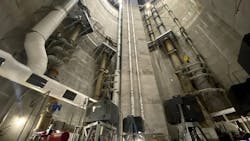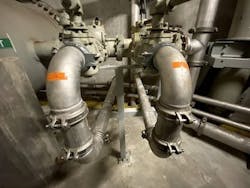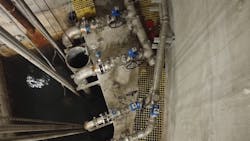Lower Meramec Wastewater Treatment Plant Upgrade
MSD was formed in 1954 to combine 79 regional sewer districts into one regional system for wastewater collection, treatment and disposal. In 2012, MSD, the Environmental Protection Agency and the Missouri Coalition for the Environment together agreed on a plan to spend billions of dollars over a span of a generation to improve water quality, build community rain-scaping, and carry out far-reaching system improvements, including upgrades to aging pipe and facilities.
Influent pump station upgrade
An essential upgrade of the Lower Meramec facility began in 2020. The original ductile iron (DI) pipe installed at the plant had experienced corrosion, and MSD made the decision to replace the DI piping – much of which was 200 feet below grade – with stainless steel (SS) for greater corrosion resistance and longevity. The upgrade to the influent pump station also included installing dehumidifiers and upgrading ductwork to fiberglass. This would improve the ambient conditions and inhibit corrosion. Sealing the concrete walls of the pump station with a special type of waterproofing material would also prevent water ingress. MSD partnered with KCI and Haberberger Mechanical Inc. to carry out the mechanical portion of the upgrades.
The nature of construction projects tends to make successful execution a challenge. Normally, there are multiple companies working side by side in different specialized roles, and there are many parallel moving parts, all of which need to be closely managed. More significantly, the interdependence of events means it is vitally important to ensure every component of the project is moving forward as planned to prevent situations in which planning glitches negatively impact the project schedule.
To achieve success on this project, Haberberger needed more than a product and service provider. The contractor had selected Victaulic solutions to join the new SS piping system, but it wanted a partner that would do more than suggest areas where specific products and services could add value.
“Haberberger sells itself as a quality contractor,” said Tim Schneider, Haberberger project manager. “We are the answer men. We don’t leave a project with loose ends.”
That meant the company needed a partner for this project that would have personnel on site and on call who were as committed to superior execution as Haberberger.
Haberberger selected Victaulic because of its similar approach and high standards for performance.
“They are unparalleled in the pipe, valves, and fittings sector and provided us with the support and solutions we needed for every part of the project,” Schneider said.
Project Execution
The Victaulic team was involved from the outset of the Lower Meramec upgrade project. Team members participated in a walkthrough of the plant with the engineers to provide expertise on solutions that would achieve the corrosion resistance requirements and expedite installation.
Among the stainless steel products specified for the pump station were 4-, 6-, and 8-inch grooved couplings, valves, and fittings on the subsurface drain lines. High-pressure pumps feed influent through these lines 200 feet below grade to the 72-inch pipes on the surface that feed the entire plant. Following the walkthrough, the Victaulic Virtual Design and Construction (VDC) team spent a day performing 70 scans of the pump station to create a 3D model for the project.
RELATED: [Video] Evolving Technologies Are Changing How Engineers Work
Because Victaulic was able to provide full Building Information Modeling (BIM) services, Haberberger was relieved of the burden of allocating its own BIM department resources to the upgrade, which enabled the company’s in-house experts to work on modeling the new fiberglass ductwork for the project and to continue their work on other active projects while the Lower Meramec work was underway.
Using the 3D model created from the scans, the VDC team created a 10,000-ft view of the entire project. This model allowed them to identify potential issues that could arise with pipe misalignments or interferences and introduce solutions before workers encountered issues in the field. These efficiencies not only expedited construction, they translated into cost reductions on the project.
Drawing on its team of internal experts, Victaulic was able to identify one specific challenge early on in the design process and apply the expertise of its engineers to resolve it. One segment of the project required the piping system to be routed within the confines of a circular station. Taking into account the space constraints and the piping requirements, the VDC team found a way to design the piping system in exact lengths that ensured all the components would align properly. The materials were fabricated and delivered to the site such that they would be ready for installation upon delivery.
The team’s ability to not only identify problems but also offer viable solutions changed the dynamic between the companies. Instead of worrying about construction challenges, Harberberger began to rely on the VDC team to function as an extension of its own and to feel confident that the project was progressing following a unified set of objectives.
Resolving challenges
While the overall execution went smoothly, the project was not without its challenges, Schneider said.
“Like all projects, this one threw us some curve balls," he said.
The most challenging “curve ball” with the Lower Meramec upgrade progress was logistics issues caused by the pandemic. Due to varying global restrictions presented by COVID-19, some of the critical components for the project were impacted. Under normal conditions, the restrictions would not have been an issue. However, the shutdowns created by the coronavirus and the subsequent impact on shipping introduced conditions that could have dramatically compromised the timeline.
Realizing the gravity of the situation, Victaulic and Haberberger worked together to develop a stop-gap fix, using temporary spools and couplings that could be installed to allow the plant to continue to function and for construction to move ahead while the delayed components were in transit.
“On a large project with tight deadlines, you only have so much bandwidth,” Schneider said, “and it’s not possible to solve every problem that comes up by yourself. You need a partner you can trust.”
Another challenge arose on this project with the discovery that several 6-inch DI pipe nipples on the bottom of a large header had to be trimmed and grooved in the field on a live fluid influent line before they could be connected to the SS pipe. The Haberberger team had to find a solution that could be carried out safely with the pipe in service.
Connecting DI and SS meant there was a possibility that the galvanic bond would not be broken, which would create the potential for corrosion down the road at the connection point between the two metals. Victaulic suggested using a proprietary coupling that breaks the galvanic bond when it is installed and introduced Haberberger to a special grooving tool that would enable workers on the site to prepare the DI pipe in the field so the coupling could be installed.
When Haberberger agreed to consider the grooving tool, Victaulic located the tool and sent three experienced installers to the Haberberger Fabrication Facility for training on using it in the field. Together, Haberberger and Victaulic created a makeshift simulation scenario in the shop to allow the installers to practice using the tool in conditions similar to those they would encounter in the field. Even though the newly trained installers were required to use the tool in less than ideal field conditions, they were able to cut the nipple to the right length and field-groove it for reconnection without incident.
“When we use products from other providers, the depth of resource isn’t there for this kind of problem-solving,” Schneider said.
Exceptional coordination and communication throughout the project allowed Victaulic to take action when issues arose and introduce solutions that ensured construction never slowed down.
Building on Success
Having the right partner can mean the difference between meeting the project schedule or missing the construction deadline. In executing this upgrade, Haberberger had found a partner that integrated swiftly with its team, understood the project objectives, and was willing to commit not only its resources but depth of experience to bring solutions. Attention to detail at every stage of the upgrade paved the way for Haberberger to bring the project to a successful conclusion.
“That’s what I look for when I have a complicated project,” Schneider said. “I want to have the best resources at my disposal.”
About the author: Wayne Biery is vice president of product development of infrastructure for Victaulic. Biery can be reached at [email protected]. Dale Petroski is infrastructure regional manager for Victaulic. Petroski can be reached at [email protected].



